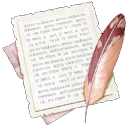User:Cedh/Munnaaqiú
|
| Munnaaqiú [mun.nɑ.ɑ.qeˈú] | |
| Period | |
| Spoken in | Siixtaguna subcontinent |
| Total speakers | |
| Writing system | none |
| Classification | Núalís-Takuña languages Munnaaqiú |
| Typology | |
| Basic word order | |
| Morphology | |
| Alignment | |
| Credits | |
| Created by | Cedh and whoever wants to help |
| What I have here so far is basically just the outcome of a set of sound changes that attempt to make Proto-Núalís-Takuña look like Inuktitut. If anyone is interested in contributing to the grammar or even in taking it over completely, you're welcome to do so! Cedh 22:56, 23 May 2011 (UTC) |
Munnaaqiú is a language of the Núalís-Takuña family. The name simply means "our speech" (← PNT mukanaakaíw) and is not much more than a conventional label; among native speakers the language is just as frequently referred to as Panuuváuqa (← panu’’áwkua "we are understood").
Phonology
Consonants
| labial | coronal | palatal | velar | uvular | |
|---|---|---|---|---|---|
| nasal | m | n | ŋ | ||
| plosive | p | t | k | q | |
| fricative | s | ||||
| approximant | ʋ | l | j | ʁ |
- /ʋ j ʁ/ are written v y r; all other consonants are written as in IPA, except that [ŋk] is written nk.
- All consonants except for v y r can occur as geminates. Geminate /ll/ is typically pronounced as a long voiceless lateral fricative [ɬː] or a voiceless lateral affricate [tɬ].
Vowels
| front | back | |
|---|---|---|
| close | i · iː | u · uː |
| open | a · aː | |
- Long vowels are written double: ii aa uu. These are often pronounced as two separate syllables, especially in accented positions. (Because of this, long vowels arguably do not have phonemic status as independent segments, but they occur much more frequently in speech than other vowel sequences and have therefore been included in the above table nonetheless.)
- Near uvular consonants, all vowels are lowered/backed considerably, typically being realized as something like [e ɑ o].
- Near coronal consonants and /j/, a is often fronted to [æ].
Phonotactics
Munnaaqiú has a fairly simple (C)V(C) syllable structure. Most consonant clusters that are brought together by morphology are assimilated to a geminate version of the second consonant; only clusters of s l or a nasal followed by a plosive or of r followed by a nasal are not simplified. The homoorganic nasal+stop clusters mp nt nk nq can appear both medially and initially.
- The consonants v y do not appear in clusters at all.
- p t k q are the only consonants that can appear in word-final position.
Pitch accent
On stressed syllables only, Munnaaqiú exhibits a tonal distinction that is best described as pitch accent. In most words, the stressed syllable - whose position is lexically and morphologically determined and thus distinctive - has a higher pitch than surrounding syllables; this is indicated with an acute accent (í á ú). However, in many words that have undergone an accentual shift since the time of Proto-Núalís-Takuña, the stressed syllable can also have low pitch, marked with a grave accent (ì à ù). Note that the accent can move with the addition of affixes.
Sample words
- Nuuvaqíuŋŋu [nuː.ʋɑˈqé.ʊŋ.ŋu] ← Nuwakaíwkañu
- qaarìt [qɑ.ɑˈʁèt] ← ka’ajta
- ntavú [ntæˈʋú] ← ta’mú
- qakkaùt [qɑk.kɐˈùt] ← kaw’akáw’a
- inayàara [i.næˈjɑ̀ː.ʁɑ] ← ina’ia’ia
- kispaá [kis.pɐˈá] ← kisuma’á
- viŋaì [ʋi.ŋɐˈì] ← uíñuj
- pullávut [puɬˈɬǽ.ʋut] ← pu’rá’mu’
Sound changes from Proto-Núalís-Takuña
- → see talk page for a WIP version of the sound changes
